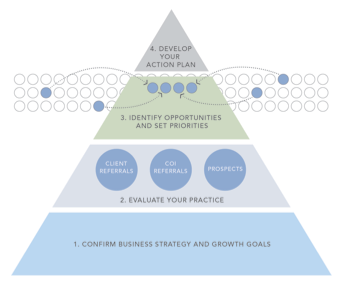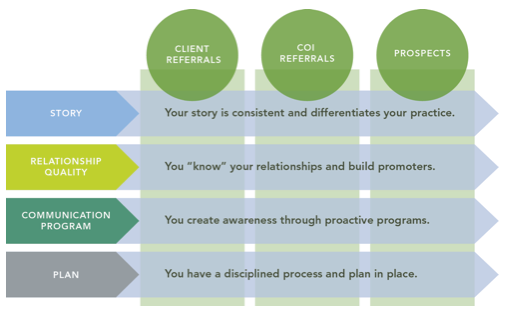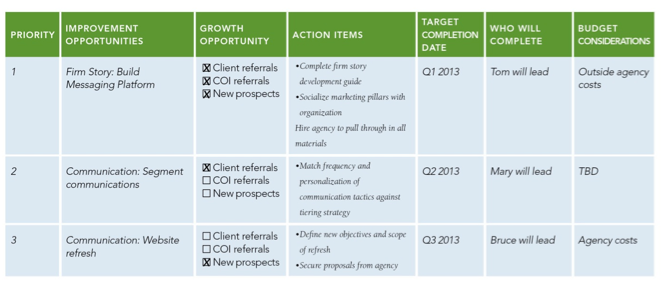My kids love to celebrate birthdays at Chuck E. Cheese, ever hopeful that they’ll win big so they can get one of those “great prizes.” Their favorite game is Whac-a-Mole, with the older one whacking away at anything that moves and the younger one waiting for the prize tickets to emerge from the slot.
Watching them recently, I recalled a conversation with advisors and their questions about marketing. “Should I do advertising?” “Should I do direct mail?” “What about a Google Adwords?” “Social media is all the rage, what about that?” “How about direct mail?” It was like Whac-A-Mole. No strategy, just reactive tactics. Many advisors think that if they whack at enough tactics, something will stick and there’ll be prizes at the end.
My response to their questions is always, “It depends.” Some tactics are effective, but what works for one firm doesn’t guarantee success for another. Advisors should have a process for developing a plan. When I work with advisors, I use our Four Steps to Energizing Your Business Development and Marketing Plan:
Step 1. Goal Setting
Step 2. Evaluating Your Practice
Step 3. Identifying Opportunities and Setting Priorities
Step 4. Developing an Action Plan
Goal Setting
It’s been said that you can’t know where you’re going without knowing where you’ve been. For advisors, this means looking beyond the AUM target to the underlying drivers of AUM growth. You can see where new assets will likely come from by reviewing current year metrics such as:
• Referrals. How many client and center-of-influence relationships are currently referring? Are those enough to generate the type of growth the firm is looking for? What was the average AUM associated with each referral? How much more and what type of nurturing is required to match or exceed the current increase?
• Win rate. Of the prospects the firm met with, how many came on board? What was the average cycle time from initial meeting to conversion? To what were losses attributed? What will reduce the cycle time and increase the win rate?
These numbers enable a firm to set realistic targets for the following year and provide insights that can aide in defining focus areas for future marketing and business development efforts. The result of this first step might be:

Goal: Increase overall AUM by X% in the next year
Objective 1. Client Referrals: Increase existing client accounts by X.
Objective 2. Center-of-Influence Referrals: Cultivate Y strategic COI relationships.
Objective 3. New Opportunities Prospects: Increase Web site leads by Z
These are all specific and measurable, and responsibility can be assigned for the purpose of evaluation and accountability.
Evaluating Your Practice
Before selecting tactics, make sure that your fundamentals are solid and that you’ve thoroughly analyzed opportunities for improvement. I encourage advisors to review four key areas, described below and evaluate how they’re doing against each. You might find it helpful to “grade” your current efforts as you peruse the statements in each key area.
• Firm Story. Your story is consistent and differentiates your practice. It is clear and easy to repeat. Everyone in the firm, from the receptionist to the most senior partner, knows how to tell it. It is consistently pulled through in all materials, both print and online, including all prospect and client pieces. When clients or centers of influence introduce you to others, the language they use to describe you matches key messages from your firm story.
• Relationship Quality. You “know” your relationships and build promoters. You routinely monitor client satisfaction. You know who your fans are, and systematically collect and capture sufficient information about them – their hobbies and personal interests, affiliations, philanthropic interests, communication preferences, and more -- that can be leveraged in building long-term relationships. Everyone on the team knows how to build the right kind of rapport with prospects, and executes well when a prospect visits the office.
• Communication Program. You create awareness through proactive programs. Your firm’s communications have both depth and quality, and occur according to a schedule. They are ongoing, and include a variety of topics and mediums. Special attention is given to those driving referrals by augmenting standard communications with relationship building tactics like periodic phone calls, emails, and personalized follow-ups to specific client interests.
• Plan. Your firm has a disciplined business development process and client acquisition plan in place that drills down to each individual advisor. You meet regularly to evaluate progress against the written plan, track referrals, and proactively discuss next steps. You would describe the firm as having a “business development culture,” where each advisor specifically allocates time for business development activities, among his or her other primary responsibilities.

This style of assessment may reveal some areas of confidence and some that need improvement. Regardless of your results, undertaking an overall process like this can bring research, logic and order to your business development and marketing efforts and free you from the reactive, frenzied game of Whac-a-Mole.
Identifying Opportunities And Setting Priorities
Using the results of the Step 2 assessment, it’s time to move forward. That includes reviewing areas of improvement and identifying specific fixes that might have the greatest positive impact given inherent limitations on time and resources. You should be as realistic and concrete as possible.
Here’s an example of some opportunities that may surface from the assessment. Let’s say that as a result of your assessment for Firm Story you determine that your message is not differentiated, is unclear and not easy to repeat. Under Relationship Quality, you've recognized that while you feel you know your clients well, you don't have a solid grasp on leveraging key center-of-influence relationships. Under Communications, you've taken a one-size-fits-all approach to segmenting your outreach and your Web site is not easily found by prospects. And, finally, under Plan, you acknowledge that you don't have a business development culture in place and that you are not measuring and monitoring your plan on a regular basis.
All these opportunities are worthy of your focus, but resources are often tight and you can't address them all at once. How do you set priorities? You can start by looking at which channel (i.e., client referrals, center-of-influence referrals and prospects) has produced your greatest growth. Where do you think your growth will come from next year? If most of the growth is from client referrals, you'll want to prioritize those opportunities that help you drive that channel strategy. From there, which areas are fundamental to setting the right course and helping all channels? For instance, a good Web site is important for communicating your message to those who don't know you, but nailing your overall firm story is fundamental to everything you do and will benefit all three areas of growth.

This type of goals-based prioritization not only helps you focus, but can shape your action plan with tangible tasks that can be tracked and measured.
Developing An Action Plan
Once you’ve set goals, identified gaps in your practice, and established priorities, it’s time to develop your action plan. Start by reviewing the opportunities you’ve identified for each of your priority-focus areas. Document which specific actions you should undertake and in what order, to drive growth and results. Identify a target completion date for each opportunity, along with the person who will be held responsible and accountable for delivering results. Don’t forget to consider budget implications and availability.
Documentation for this Step 4 might look as follows:

Remember to review the action plan regularly to ensure that you’re hitting your target dates and desired metrics. You might want to consider reviewing this entire approach – Steps 1 through 4 – on an annual basis. As your practice, clientele, and overall business environment evolve, you can revisit your targeted improvement areas to ensure that they are still pressing, as well as delete completed areas and actions.
The plan itself should serve as your proactive filter to investigate and potentially implement new tactics, where appropriate, given your unique practice goals.
If you’re like the other advisors I know who follow this type of methodical process, you may find that as each planned year passes, your marketing and business development is much more confident and impactful, and you've left the world of “Whac-A-Mole” behind.
Ross Ozer is senior vice president and head of marketing for Fidelity Institutional Wealth Services. He also leads the marketing consulting practice, where he helps advisors maximize their marketing efforts to drive new growth for their businesses.








